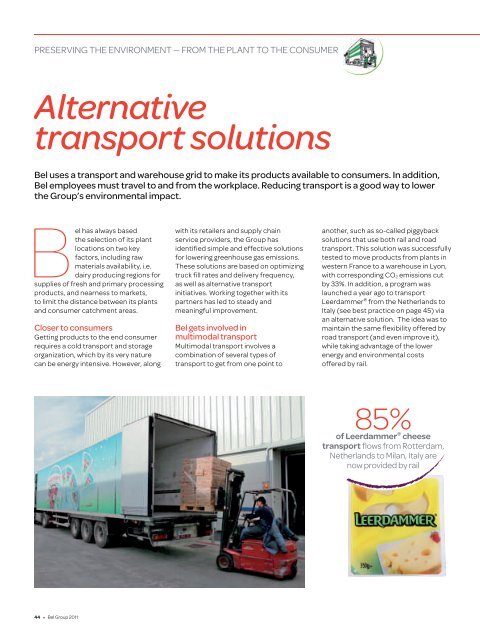The Bel - visit site - Bel Group
The Bel - visit site - Bel Group
The Bel - visit site - Bel Group
Create successful ePaper yourself
Turn your PDF publications into a flip-book with our unique Google optimized e-Paper software.
PRESERVING THE ENVIRONMENT — FROM THE PLANT TO THE CONSUMER<br />
Alternative<br />
transport solutions<br />
<strong>Bel</strong> uses a transport and warehouse grid to make its products available to consumers. In addition,<br />
<strong>Bel</strong> employees must travel to and from the workplace. Reducing transport is a good way to lower<br />
the <strong>Group</strong>’s environmental impact.<br />
<strong>Bel</strong> has always based<br />
the selection of its plant<br />
locations on two key<br />
factors, including raw<br />
materials availability, i.e.<br />
dairy producing regions for<br />
supplies of fresh and primary processing<br />
products, and nearness to markets,<br />
to limit the distance between its plants<br />
and consumer catchment areas.<br />
Closer to consumers<br />
Getting products to the end consumer<br />
requires a cold transport and storage<br />
organization, which by its very nature<br />
can be energy intensive. However, along<br />
44 • <strong>Bel</strong> <strong>Group</strong> 2011<br />
with its retailers and supply chain<br />
service providers, the <strong>Group</strong> has<br />
identified simple and effective solutions<br />
for lowering greenhouse gas emissions.<br />
<strong>The</strong>se solutions are based on optimizing<br />
truck fill rates and delivery frequency,<br />
as well as alternative transport<br />
initiatives. Working together with its<br />
partners has led to steady and<br />
meaningful improvement.<br />
<strong>Bel</strong> gets involved in<br />
multimodal transport<br />
Multimodal transport involves a<br />
combination of several types of<br />
transport to get from one point to<br />
another, such as so-called piggyback<br />
solutions that use both rail and road<br />
transport. This solution was successfully<br />
tested to move products from plants in<br />
western France to a warehouse in Lyon,<br />
with corresponding CO2 emissions cut<br />
by 33%. In addition, a program was<br />
launched a year ago to transport<br />
Leerdammer ® from the Netherlands to<br />
Italy (see best practice on page 45) via<br />
an alternative solution. <strong>The</strong> idea was to<br />
maintain the same flexibility offered by<br />
road transport (and even improve it),<br />
while taking advantage of the lower<br />
energy and environmental costs<br />
offered by rail.<br />
85%<br />
of Leerdammer ® cheese<br />
transport fl ows from Rotterdam,<br />
Netherlands to Milan, Italy are<br />
now provided by rail


